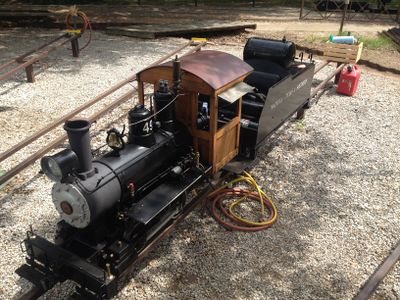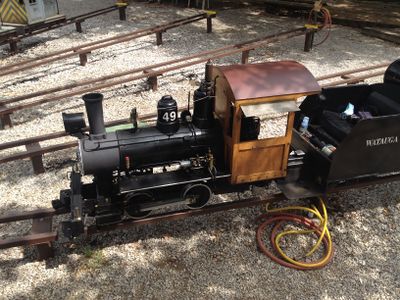Wayne Davis: Difference between revisions
(Created page with "Category:Construction Category:People By Daris A. Nevil 18 May 2014 Wayne Davis is a member of the Annetta Valley & Western Railroad. At a recent club meet Way...") |
No edit summary |
||
| Line 6: | Line 6: | ||
18 May 2014 | 18 May 2014 | ||
Wayne Davis is a member of the [[Annetta Valley & Western Railroad]]. At a recent club meet Wayne explained how he built his freelance 2-1/2 scale narrow gauge 0-4-0. He made most of the parts from scrap components, or as he explains it, from "dumpster diving". It should be noted that Wayne is not a machinist. He is a retired forklift mechanic. His first experience at machining began with the construction of Number 49 | Wayne Davis is a member of the [[Annetta Valley & Western Railroad]]. At a recent club meet Wayne explained how he built his freelance 2-1/2 scale narrow gauge 0-4-0. He made most of the parts from scrap components, or as he explains it, from "dumpster diving". It should be noted that Wayne is not a machinist. He is a retired forklift mechanic. His first experience at machining began with the construction of Number 49 about twelve years ago. | ||
Wayne saw other 2-1/2 inch narrow gauge locomotives and liked how large the controls were, and how easy they were to access. He also wanted to build a tender that he could actually sit in, not on. As you can see in the photos below, Wayne's locomotive satisfied these requirements. At the meet mentioned previously, Wayne operated his steam engine 5-1/2 hours straight to provide rides for a large group of visitors, never stopping except to handle "personal business." | Wayne saw other 2-1/2 inch narrow gauge locomotives and liked how large the controls were, and how easy they were to access. He also wanted to build a tender that he could actually sit in, not on. As you can see in the photos below, Wayne's locomotive satisfied these requirements. At the meet mentioned previously, Wayne operated his steam engine 5-1/2 hours straight to provide rides for a large group of visitors, never stopping except to handle "personal business." | ||
| Line 12: | Line 12: | ||
Wayne's first acquisition was cast iron material. While visiting Walmart with his wife Wayne noticed some ten-pound dumb bell weights for $2 each. He purchased one and took it home to find out the quality of the casting. A cut into the weight revealed that it was high quality cast iron. Wayne used the ten pound weights for the drivers and cut out all the valve linkage parts from the same material. He cut the bell frame from a 2-1/2 pound cast iron weight. | Wayne's first acquisition was cast iron material. While visiting Walmart with his wife Wayne noticed some ten-pound dumb bell weights for $2 each. He purchased one and took it home to find out the quality of the casting. A cut into the weight revealed that it was high quality cast iron. Wayne used the ten pound weights for the drivers and cut out all the valve linkage parts from the same material. He cut the bell frame from a 2-1/2 pound cast iron weight. | ||
The holes in exercise weights were about 1-1/4 inch in diameter, far too large for a | The holes in the ten pound exercise weights were about 1-1/4 inch in diameter, far too large for a reasonbly sized axle. Wayne struck upon the idea of using [[http://www.mcmaster.com/#taper-bushings/=s0uuxz taper bushings from McMaster-Carr]]. He had seen these on a conveyor system, and they looked like they would fit the bill. And indeed they did. They are secured by two count-sunk hex head bolts. Removal is also easy, using a single hex head bolt in the middle of the bushing to pull it away from the taper. | ||
Wayne expanded his search for cast iron parts. He found a cast iron frying pan with a broken handle for $1.99 that became the smoke box front, and a cast iron lid became the door. Inverted cast iron posts were used for the bases of the steam and sand | Wayne expanded his search for cast iron parts. He found a cast iron frying pan with a broken handle for $1.99 that became the smoke box front, and a cast iron lid became the door. Inverted cast iron posts were used for the bases of the steam and sand domes. They were contoured to fit the boiler. Notice the lid for the sand dome is the handle of a cast iron lid. | ||
A neighbor's discarded water-heater supplied the sheet metal [[Lagging|lagging]] for the boiler, with white fiberglass felt for boiler insulation. | A neighbor's discarded water-heater supplied the sheet metal [[Lagging|lagging]] for the boiler, with white fiberglass felt for boiler insulation. | ||
Wayne built the boiler himself, too. It is a [[Briggs boiler]], which greatly simplified fabrication. It is constructed from a seamless tube. His brother-in-law suggested he burn coal, but Wayne felt it was too messy (besides coal is difficult to obtain in Texas). He settled on " | Wayne built the boiler himself, too. It is a [[Briggs boiler]], which greatly simplified fabrication. It is constructed from a seamless tube. His brother-in-law suggested he burn coal, but Wayne felt it was too messy (besides coal is difficult to obtain in Texas). He settled on "Texas tea" and constructed a "pot burner" (oil drip pan burner). The boiler is fitted with two [http://www.aquatrol.com/ Acquatrol safety valves]. | ||
A scratch built [[Turbo Generator|turbo generator]] was added which uses a small generator from the steering control of a forklift. | A scratch built [[Turbo Generator|turbo generator]] was added which uses a small generator from the steering control of a forklift. | ||
Construction time for this locomotive? Wayne said he completed the project in two years. It is a fine | Construction time for this locomotive? Wayne said he completed the project in two years. It is a fine looking, smooth running and great sounding locomotive that sees lots of service on the AV&WRR. | ||
<gallery widths="400px" heights="400px"> | |||
File:WayneDavis freelance narrowgauge 20140517 01.jpg | |||
File:WayneDavis freelance narrowgauge 20140517 02.jpg | |||
File:WayneDavis freelance narrowgauge 20140517 03.jpg|The rear driver is a ten pound cast iron exercise weight with a steel tire. | |||
File:WayneDavis freelance narrowgauge 20140517 04.jpg | |||
</gallery> | |||
Revision as of 21:44, 18 May 2014
By Daris A. Nevil
18 May 2014
Wayne Davis is a member of the Annetta Valley & Western Railroad. At a recent club meet Wayne explained how he built his freelance 2-1/2 scale narrow gauge 0-4-0. He made most of the parts from scrap components, or as he explains it, from "dumpster diving". It should be noted that Wayne is not a machinist. He is a retired forklift mechanic. His first experience at machining began with the construction of Number 49 about twelve years ago.
Wayne saw other 2-1/2 inch narrow gauge locomotives and liked how large the controls were, and how easy they were to access. He also wanted to build a tender that he could actually sit in, not on. As you can see in the photos below, Wayne's locomotive satisfied these requirements. At the meet mentioned previously, Wayne operated his steam engine 5-1/2 hours straight to provide rides for a large group of visitors, never stopping except to handle "personal business."
Wayne's first acquisition was cast iron material. While visiting Walmart with his wife Wayne noticed some ten-pound dumb bell weights for $2 each. He purchased one and took it home to find out the quality of the casting. A cut into the weight revealed that it was high quality cast iron. Wayne used the ten pound weights for the drivers and cut out all the valve linkage parts from the same material. He cut the bell frame from a 2-1/2 pound cast iron weight.
The holes in the ten pound exercise weights were about 1-1/4 inch in diameter, far too large for a reasonbly sized axle. Wayne struck upon the idea of using [taper bushings from McMaster-Carr]. He had seen these on a conveyor system, and they looked like they would fit the bill. And indeed they did. They are secured by two count-sunk hex head bolts. Removal is also easy, using a single hex head bolt in the middle of the bushing to pull it away from the taper.
Wayne expanded his search for cast iron parts. He found a cast iron frying pan with a broken handle for $1.99 that became the smoke box front, and a cast iron lid became the door. Inverted cast iron posts were used for the bases of the steam and sand domes. They were contoured to fit the boiler. Notice the lid for the sand dome is the handle of a cast iron lid.
A neighbor's discarded water-heater supplied the sheet metal lagging for the boiler, with white fiberglass felt for boiler insulation.
Wayne built the boiler himself, too. It is a Briggs boiler, which greatly simplified fabrication. It is constructed from a seamless tube. His brother-in-law suggested he burn coal, but Wayne felt it was too messy (besides coal is difficult to obtain in Texas). He settled on "Texas tea" and constructed a "pot burner" (oil drip pan burner). The boiler is fitted with two Acquatrol safety valves.
A scratch built turbo generator was added which uses a small generator from the steering control of a forklift.
Construction time for this locomotive? Wayne said he completed the project in two years. It is a fine looking, smooth running and great sounding locomotive that sees lots of service on the AV&WRR.



